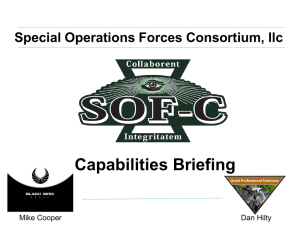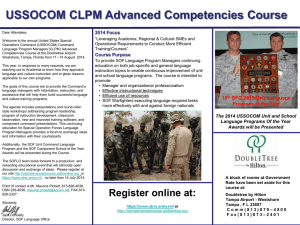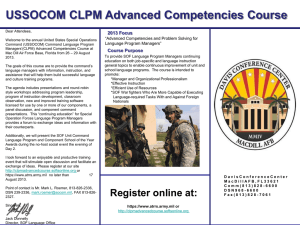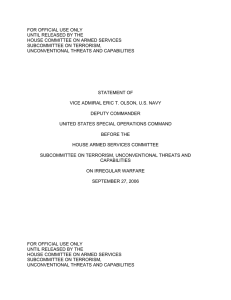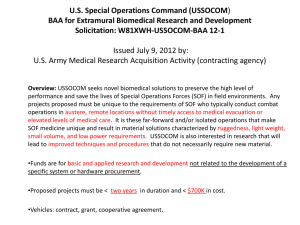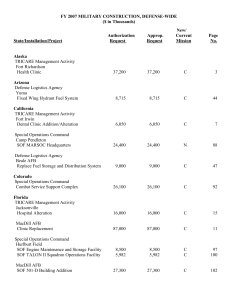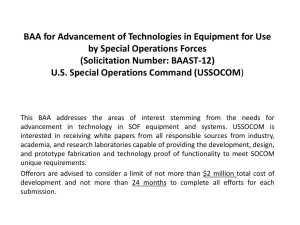Document 11762603
advertisement
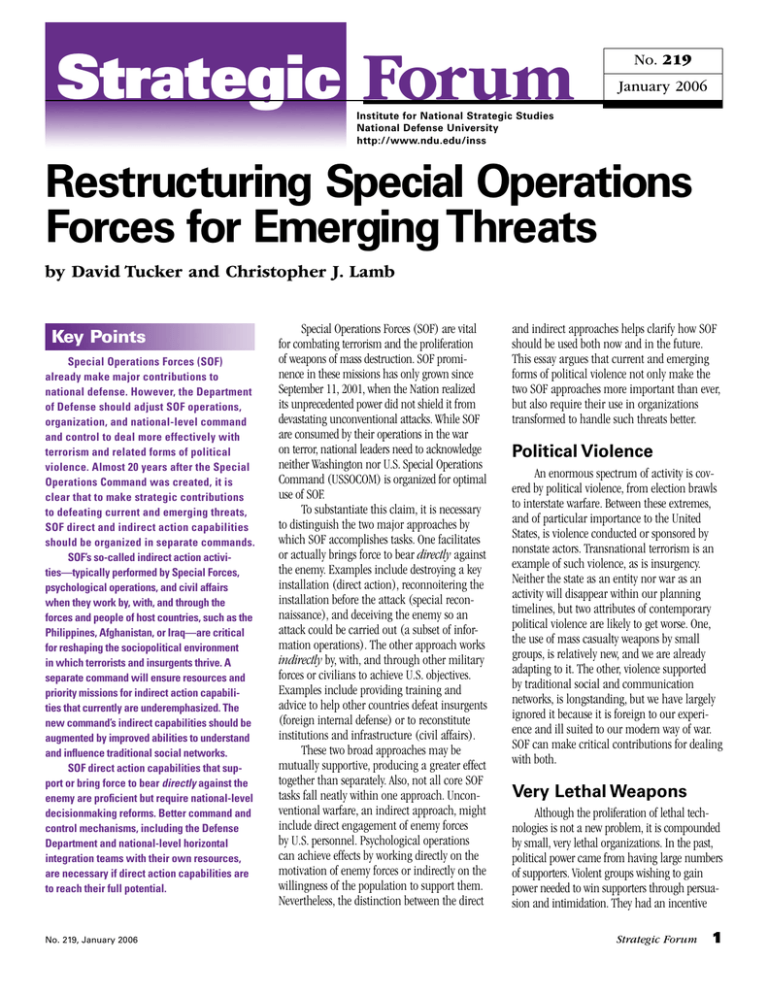
Strategic Forum No. 219 January 2006 Institute for National Strategic Studies National Defense University http://www.ndu.edu/inss Restructuring Special Operations Forces for Emerging Threats by David Tucker and Christopher J. Lamb Key Points Special Operations Forces (SOF) already make major contributions to national defense. However, the Department of Defense should adjust SOF operations, organization, and national-level command and control to deal more effectively with terrorism and related forms of political violence. Almost 20 years after the Special Operations Command was created, it is clear that to make strategic contributions to defeating current and emerging threats, SOF direct and indirect action capabilities should be organized in separate commands. SOF’s so-called indirect action activities—typically performed by Special Forces, psychological operations, and civil affairs when they work by, with, and through the forces and people of host countries, such as the Philippines, Afghanistan, or Iraq—are critical for reshaping the sociopolitical environment in which terrorists and insurgents thrive. A separate command will ensure resources and priority missions for indirect action capabilities that currently are underemphasized. The new command’s indirect capabilities should be augmented by improved abilities to understand and influence traditional social networks. SOF direct action capabilities that support or bring force to bear directly against the enemy are proficient but require national-level decisionmaking reforms. Better command and control mechanisms, including the Defense Department and national-level horizontal integration teams with their own resources, are necessary if direct action capabilities are to reach their full potential. No. 219, January 2006 Special Operations Forces (SOF) are vital for combating terrorism and the proliferation of weapons of mass destruction. SOF prominence in these missions has only grown since September 11, 2001, when the Nation realized its unprecedented power did not shield it from devastating unconventional attacks. While SOF are consumed by their operations in the war on terror, national leaders need to acknowledge neither Washington nor U.S. Special Operations Command (USSOCOM) is organized for optimal use of SOF. To substantiate this claim, it is necessary to distinguish the two major approaches by which SOF accomplishes tasks. One facilitates or actually brings force to bear directly against the enemy. Examples include destroying a key installation (direct action), reconnoitering the installation before the attack (special reconnaissance), and deceiving the enemy so an attack could be carried out (a subset of information operations). The other approach works indirectly by, with, and through other military forces or civilians to achieve U.S. objectives. Examples include providing training and advice to help other countries defeat insurgents (foreign internal defense) or to reconstitute institutions and infrastructure (civil affairs). These two broad approaches may be mutually supportive, producing a greater effect together than separately. Also, not all core SOF tasks fall neatly within one approach. Unconventional warfare, an indirect approach, might include direct engagement of enemy forces by U.S. personnel. Psychological operations can achieve effects by working directly on the motivation of enemy forces or indirectly on the willingness of the population to support them. Nevertheless, the distinction between the direct and indirect approaches helps clarify how SOF should be used both now and in the future. This essay argues that current and emerging forms of political violence not only make the two SOF approaches more important than ever, but also require their use in organizations transformed to handle such threats better. Political Violence An enormous spectrum of activity is covered by political violence, from election brawls to interstate warfare. Between these extremes, and of particular importance to the United States, is violence conducted or sponsored by nonstate actors. Transnational terrorism is an example of such violence, as is insurgency. Neither the state as an entity nor war as an activity will disappear within our planning timelines, but two attributes of contemporary political violence are likely to get worse. One, the use of mass casualty weapons by small groups, is relatively new, and we are already adapting to it. The other, violence supported by traditional social and communication networks, is longstanding, but we have largely ignored it because it is foreign to our experience and ill suited to our modern way of war. SOF can make critical contributions for dealing with both. Very Lethal Weapons Although the proliferation of lethal technologies is not a new problem, it is compounded by small, very lethal organizations. In the past, political power came from having large numbers of supporters. Violent groups wishing to gain power needed to win supporters through persuasion and intimidation. They had an incentive Strategic Forum to limit the use of violence lest they alienate potential supporters and stiffen the resistance of opponents. If they used excessive violence, they were unlikely to win and risked creating a backlash that might destroy them. Thus, in the past, terrorist groups that wanted to grow into political movements limited the amount of violence they used. Some recent evidence suggests that this logic apparently characterizes even the al Qaeda jihadist movement.1 Nevertheless, the spread of increasingly lethal technologies complicates analysis of terrorist violence. While it is not true, as often supposed, that terrorists are free to choose a level of violence or lethality based on religious, ethnic, or idiosyncratic views, extraordinarily lethal technology is likely to lead (indeed, has already led) some terrorists to think that this technology is a shortcut to power, circumventing the need to build political support. Thus, given advances in technology and their diffusion, we are likely to see small groups that have no ambition to grow through traditional political means and, hence, no motivation for moderation. Instead, they will seek political power through the possession of terrible weapons. We also occasionally will face groups that want such weapons because members see them as a way of ending the world as we know it. There really is no solution to the problem of small, very lethal organizations other than taking all possible measures to prevent the acquisition of weapons of mass destruction, and directly eliminating the group or its members before they employ any such weapons they have. The SOF direct action approach is well suited to combating small lethal organizations, and it receives much attention as the Department of Defense (DOD) emphasizes hunting down the al Qaeda leadership. However, the way in which traditional social and communication networks may support terrorism and violent political movements is an often-ignored dimension of political violence that also calls for SOF capabilities. Since we tend to pay little attention to this phenomenon, it requires some explanation. Traditional Networks The 9/11 plotters, like the jihadist movement generally, used the Internet and jet travel. They also used the hawala2 money transfer system and a global network of mosques. They operated in the modern world of individualism, electronic media, centralized bureaucratic control, and cellular phones. They also operated in a traditional, nontechnical world of family and tribe and decentralized, socially based authority. The terrorists operate in two worlds; we operate in only one. Thus, they have more strategic depth than we do. The security advantage the jihadists acquire from using traditional networks is most evident. Our information and intelligence collection capabilities are optimized for the modern world only. Human intelligence as a bureaucratic enterprise developed traditional social networks provide our enemies with significant advantages in Europe with the European state system. Technical intelligence developed later and reflects this system and its centralized bureaucracies. Both human and technical intelligence have adapted to that world. We can intercept electronic messages and track money through the international banking system better than we can track money in the hawala system or understand what goes on in religious brotherhoods. The socially based security advantage that terrorists enjoy (and our corresponding disadvantage) is perhaps the most glaring consequence of our inability to operate in the traditional social world, but two others are also important. First, because they are organizations at risk, terrorist groups tend to recruit from among those they trust, which typically means from among their existing social relationships—family, kin, friends, mosque attendees.3 The strength of traditional social networks is an important advantage in the recruiting David Tucker is an associate professor of defense analysis at the Naval Postgraduate School. His contribution to this article is based in part on research supported by the Smith Richardson Foundation. Christopher J. Lamb is a senior fellow in the Institute for National Strategic Studies at the National Defense University. This essay is based on research and conclusions from the authors’ forthcoming book, U.S. Special Operations Forces, to be published by Columbia University Press in 2006. Strategic Forum process, which we have only a limited ability to understand and affect. Second, we tend to think that strategic communication and the war of ideas are important for winning the war on terror, but, as far as our adversaries are concerned, that part of the struggle takes place largely at the level of the individual imam or tribal elder. Our ability to understand or influence that level of traditional communication is limited.4 In security, recruiting, and communicating, traditional social networks provide our enemies with significant advantages. Influencing Networks Not all political violence or even all terrorism gets decisive support from the traditional social world, but the kind that threatens us most now and in the foreseeable future does. Organizing SOF to deal with transnational networks will demand a good deal of change. SOF already is organized to deal with small lethal groups, and doing so better requires relatively fewer adjustments. The United States has confronted traditional networks consistently since the end of World War II. We face them now in Iraq, the Middle East, Central Asia, South and Southeast Asia, Northern Africa, in some places in Latin America—in those areas where the writ of the modern bureaucratic state does not run strong and U.S. personnel must often operate in austere and possibly violent circumstances. Only two organizations in the U.S. Government have expertise in preparing people to operate in such circumstances and supporting them once they are there: DOD and the Central Intelligence Agency’s (CIA’s) Directorate of Operations (DO). Tasking the DO to penetrate and influence traditional social and communication networks would have serious drawbacks. First, its training, structure, and incentives all focus case officers on modern information and bureaucratic state-centric systems. Case officers want to know what key decisionmakers have decided. As collectors, they take this same approach to terrorist organizations; as operators, they want to disrupt these organizations. Case officers who operate in the midst of traditional networks hardly ignore them, but the directorate is not structured, nor its personnel trained, to make traditional networks a priority, nor should they be. The traditional DO approach is necessary and needs to be done better, which will consume its time and resources. No. 219, January 2006 The second reason the directorate should not have the responsibility for understanding and influencing traditional social networks is that association with the DO risks compromising and limiting the influence of the indigenous people with whom it works. A clandestine approach should be taken only when necessary. The relationships of trust that characterize traditional social systems can be developed overtly. Clandestine tradecraft, the directorate’s core competence, is not necessary for understanding and influencing traditional social networks and would actually be counterproductive. Since a new organization devoted to traditional networks is neither necessary nor likely, eliminating the DO as an option leaves the Department of Defense as the choice to understand and influence the traditional social world. There are organizations in DOD that already do this work. When Special Forces (SF)5 engage in the indirect approach, when they work by, with, and through indigenous forces or personnel, they are often working within traditional social and communication networks. So, too, are civil affairs and psychological operations (PSYOP) forces. Some PSYOP teams in Iraq gathered and disseminated information working through and with traditional social networks, although this is not a doctrinal task for PSYOP. The work these forces do in this regard needs to be improved and augmented. Building New Capability Improving SF capabilities to operate in the traditional social world will come largely from focusing their energies on that world. SF teams currently prepare for an array of missions. If they devote their finite time and resources to the indirect approach, which must include maintaining their small unit military skills, they will get better at it. They will be able to focus selection and training on this mission, for example. They will learn more about it, and doctrine will begin to change and improve, as will the tactics, techniques, and procedures of engaging with the traditional social world. Deeper knowledge of traditional networks will make SF not only more capable for independent SOF missions but also better able to support conventional force operations. Beyond reorientation of SF, a separate cadre of specialists on traditional networks is needed. Ideally, the kinds of professionals best suited for this mission would transfer No. 219, January 2006 into their new career track in their late 20s or early 30s with prior exposure to foreign cultures and languages. Upon completion of additional specialized military and other beyond reorientation of SF, a separate cadre of specialists on traditional networks is needed training requirements, their initial assignment could be an overseas tour working in a U.S. Embassy, either for a defense attaché or on loan to the political, economic, or development assistance sections of a given country team. As with all other accredited U.S. diplomatic personnel, their specific (and overt) purpose would be to interact with the people and institutions of the host nation in order to conduct bilateral assistance programs within their scope of duties; a greater understanding of traditional social networks would be an inevitable consequence of that kind of contact. How and with whom trust and knowledge are built would depend on the interplay of local circumstances and the skills and background of each individual. A second tour would follow in a nearby country, and then a third, perhaps in the country of the first tour, with time for training and education. Long periods spent in a subregion (for example, western sub-Saharan Africa) and in one or two countries in that subregion are necessary to build relationships, knowledge, and influence. With their expertise in traditional social and communication systems, these personnel should be key advisors if American forces need to deploy to their country or region. They would help prepare SF for their training missions and other deployments, alerting them to key figures in traditional networks. These specialists could assist the Embassy public affairs officers in shaping their messages. In operational settings, they would assist PSYOP personnel in the same fashion. They would serve as eyes and ears in places that U.S. and even local officials seldom visit, which, for that reason, are places where things of interest to the United States happen. They would be able to assist State Department and other personnel in identifying individuals of interest to the United States. Information they gathered from the Lebanese community in West Africa, for example, might be of interest to U.S. personnel in the Middle East, France, and the tri-border region of Latin America, as well as to analysts and policymakers in Washington. Their information would also be useful to a range of Federal law enforcement and intelligence agencies. In addition to assisting military forces and U.S. Government agencies, this new cadre would wield its own influence, which would come from the relationships of trust it develops and from its assistance to extant overt U.S. Government programs. Ultimately, this cadre should have its own funding to provide overt assistance to key leaders and organizations in the traditional social world. This would need to be done carefully, but in some cases might consist of nothing more than a gift of food to a village. The point in such gifts would not be their munificence but rather the relationship within which they occurred. This brief outline raises a host of questions about the personnel management of these specialists.6 For example, they do not need a highly differentiated rank structure. Those who enter this work will not have command of progressively larger numbers of personnel. Hence, their status should correspond more to something like apprentice, journeyman, and master than to the traditional military hierarchy. However these and other such issues are decided (and how they are decided will be critical to the success of these specialists), the personnel system will be different from anything now found in the Defense Department. Since the organization will be small, certainly by Defense standards, it must be part of some other separate organization within the department, or it will be overwhelmed by the DOD bureaucracy. Given its function, this new organization should be grouped with the other Defense components that focus on the indirect approach so that it can complement them. Command Restructure Once the utility of grouping SF, civil affairs, PSYOP, and the new cadre of traditional social and communication network specialists is seen, further consideration suggests that they constitute a separate organization within the department. A review of SOF history and current activities shows that DOD and, more recently, USSOCOM have typically given lower priority to the indirect approach and those who carry it out. Strategic Forum Just as SOF did not flourish until separated from the conventional military under its own command, the indirect approach of SOF will not flourish unless it is separated from SOF direct action components. Thus, we suggest establishing a separate joint command in DOD—perhaps called the Unconventional Warfare Command—that would include SF, civil affairs, PSYOP, and the new cadre described above. The command would draw upon all services for personnel and would in other respects function much as USSOCOM functions now, paying for training and equipment specifically related to unconventional warfare but relying on the services for all other support. The command thus would have a Major Force Program in the DOD budget and have acquisition authority. For the indirect approach of SOF will not flourish unless it is separated from SOF direct action components example, it would take responsibility for modifying aircraft for PSYOP use. Access to transportation resources for members of the new command might require that it control some aircraft, although it may be able to rely on Air Force or Army assets for transport. It would also need authority to devise new personnel management procedures, since the current DOD procedures should not apply to the new cadre. Personnel reforms would have to extend into all the Services, however, since these personnel would have a different career progression. Over time, it might be that the personnel system of the new cadre would better fit at least some civil affairs and PSYOP personnel as well. A four-star officer should lead this new command. It will run into a host of bureaucratic problems and will need an officer at that level, plus considerable assistance from high-ranking DOD civilians, to establish itself. The primary problem in DOD for the new command will be the general disregard for the indirect approach. The State Department is likely to ignore the new command and its knowledge of traditional networks. The CIA is likely to claim first that it already does this work; next, that the work is not necessary; and finally, that it is cooperating fully, while it uses its chief of station authority to restrict where the new command sends its Strategic Forum personnel and what they do. The command will also have to sort out relations between its components and the Intelligence Community beyond CIA. For example, SF already collect information (and could learn to collect and report it better) that should interest the Intelligence Community. Even if relations with other agencies remain problematic temporarily, the new command will give the indirect approach better standing within DOD and will improve its ability to support the direct approach of SOF and conventional forces and to carry on such independent indirect missions as foreign internal defense. Altogether, the various activities of the command will give DOD and the U.S. Government the global scouts that SF are sometimes characterized to be. A critic might note the expense implicit in these proposals and wonder if they are necessary. After all, DOD and SOF have already taken some steps to address the cultural and social aspects of warfare. Although these measures will help, the underlying phenomenon of terrorism and insurgency is not cultural but social. Unless we focus on the traditional social world, we will not get better at understanding and influencing it and at mastering and using to our advantage the indirect approach to our enemies. Failing to do this, we will not deal effectively with the major problem before us. Lethal Organizations Establishing a separate command focused on the indirect approach is critical for dealing with traditional networks. It will also have an unintended benefit. SOF not in this new organization—the special mission units, the Navy Sea-Air-Land teams, the Army Rangers, the 160th Special Operations Aviation Regiment, and Air Force Combat Controllers and Pararescue personnel—will form a new organization (perhaps called the Special Operations Strike Command)7 that would retain USSOCOM’s current Service-like responsibilities and authorities but would focus on direct action missions. This organizational change would allow the Strike Command to focus on small, very lethal organizations. Such organizations will operate as terrorist groups, as radical religious sects that develop into violent organizations, or as the forces of countries that develop limited numbers of advanced weapons that they seek to use clandestinely for maximum effect. In all these cases, the U.S. Government may be compelled to act against organizations when they have such weapons or to prevent their acquisition. To do so, the best strike and raid capability possible will be needed. A confrontation with one of these organizations is likely to reveal that they possess technology as advanced as ours in enough categories to make them formidable enemies. Extremist sects, for example, have long had a tendency to retreat into compounds, but in the future, commercially available technology will be sufficiently developed to allow these nonstate groups to build not just compounds but daunting fortresses. While many such groups will pose no threat to the United States, some may threaten Americans abroad, while others will see the United States as the keystone of the order they must destroy for a new one to emerge and, hence, as their enemy. Integration Problem The new Special Operations Strike Command will not, in and of itself, give the United States a more robust direct action capability. It will only improve this capability if it is used correctly. The U.S. Government is not currently well organized to do this. These organizational defects are two-fold: lack of integration across bodies of functional expertise and familiarity with SOF capabilities. Lack of integration undermines complex endeavors such as counterterrorism or counterproliferation. SOF direct action capabilities are critical in these activities but should not be used without regard for a host of political, diplomatic, and legal issues. The lack of regular communication between civilian and even military decisionmakers and SOF direct action forces also produces failures and suboptimal performance. The integration problem results from a security bureaucracy organized around dominant organizations dedicated to expertise in a single functional area. Yet many current security problems are so complex and fast-evolving that they require the integrated expertise of many Government agencies and even nongovernmental organizations. To achieve this integration, we need new “horizontal integration” teams to draw upon but cut across functional areas to produce sound, integrated, adaptive solutions. Integration Solution To build these teams, the Secretary of Defense would authorize an individual with relevant experience and leadership skills No. 219, January 2006 to bring together subject matter experts now divided among various organizations within DOD. The team would develop strategies and plans for specific problems, such as terrorism, and oversee implementation of these plans, as well as budgetary and acquisition issues. The team would not be a task force but a structure as permanent as the problem it was designated to deal with. Comprehending the problem and solution in an end-to-end fashion, the team would use its authority to intervene selectively to ensure progress—mostly at the strategic level, where the efforts of functional organizations tend to compete and work at cross-purposes, but down to whatever level of detail was required to ensure successful outcomes. Making the transition to new horizontal organizations will be difficult. In particular, achieving unity of effort requires, at one level, violating the principle of unity of command. The experts who populate the teams report to two leaders, one in the organization they come from and the other the integration team leader, who can reward or release them, if they are not loyal and dedicated to producing civilian decisionmakers often lack sufficient understanding of direct action operations to oversee them effectively the best overall solution. This “dual authority” problem is the single point of failure for such horizontal integration teams. If the Secretary of Defense does not impress upon his immediate subordinates the importance of collaboration and information-sharing, they may instruct the experts they send to the teams to protect organizational interests at all costs. In such cases, the teams may produce “least common denominator” products that satisfy individual team members but are inconsistent and ineffective. However, if DOD can make the transition to empowered, collaborative teams, it will help tackle some of the most intractable problems that it faces. The effect would be even greater if such teams took hold across the Government to deal with key national security issues. Again, these would not be the customary interagency deliberating bodies, or even the interagency No. 219, January 2006 Executive Committees that the Clinton administration used, but small permanent organizations with authority, derived from the President, over both their agendas and their own resources, devoted to developing policies and strategies and reporting directly to the Principals Committee (the national security Cabinet-level authorities). SOF Familiarity Problem Solving the integration and coordination problem within DOD and among other national security agencies would leave another problem specific to SOF direct action capability. The command and control relationship between direct action units and senior civilian and military decisionmakers is too distant. Senior leaders must understand SOF tactical capabilities and limitations to employ SOF most effectively and discreetly. This understanding and discretion can only be developed through direct contact with SOF operational leaders and familiarity with their modes of operation. With such familiarity, senior leaders are more likely to examine and guide strategic operations critically from conception through completion. SOF operations in Somalia in 1993 are a perfect illustration of both the integration and vertical command and control problems inherent in strategic direct action. SOF Task Force Ranger was sent to Mogadishu in summer 1993 to capture Mohammed Farah Aideed, a faction leader whom the U.S. Government judged to be the key troublemaker in Somalia. Washington wanted Aideed captured in order to establish the peacemaking capabilities of the United Nations, which had taken over the effort to stabilize Somalia from the United States. This was a major policy initiative of the Clinton administration. The mission was high-risk, since it required U.S. forces to conduct raids on short notice into hostile territory, with high political stakes for the administration. In this setting, SOF commanders in the field and at USSOCOM needed to be aware of how the Nation’s political-military strategy was evolving. They needed to keep authorities informed of developments in the field and evolving risks inherent in the course of action they were pursuing. They did not do so, nor do they appear to have been inclined to do so. But even if they had been, there was no single Washington-based authority they could have reported to that would have been able to provide definitive guidance and to change course quickly in light of developments in the field. As the Senate report on the Somalia expedition concluded, U.S. policies were poorly coordinated, and civilian officials and military leaders were not carefully and continually reevaluating the SOF mission to determine if the risks were too high.8 This failure to coordinate policy and operations contributed significantly to the failure of the SOF mission in Somalia and to a strategic and political failure for the United States. The argument might be made that a new and naïve administration was responsible for the confusion in Washington when Task Force Ranger was deployed to Somalia. However, such setbacks have characterized the administrations of Presidents both new and seasoned. The fault lies not only in poor leadership but also in poor organization. An integrated team operating in DOD—or preferably across the relevant national security departments and agencies—as the single authority for policy and operations could have eliminated or at least diminished the command and control problems that ultimately contributed to failure in Somalia. SOF Familiarity Solution Effective command and control of SOF direct action missions will not come automatically from linking direct action capabilities to the integrated teams proposed here or to the President following their advice. The characteristics of both decisionmakers and operators tend to undermine effective command and control. For example, as the Senate report on Task Force Ranger noted: One of the weaknesses of a unit like Task Force Ranger, whose combat capabilities are unparalleled, is the belief by the unit members and its commanders that they can accomplish any mission. Because of the supreme confidence of special operations forces, the chain of command must provide more oversight to this type of unit than to conventional forces.9 However, civilian decisionmakers often lack sufficient understanding of direct action operations to oversee them effectively. Senior military commanders may also lack such understanding and often have prejudices against SOF.10 The result is that DOD integrated teams made up of such civilian and military leaders alone will not be able to provide the oversight that SOF need. If special operations are to achieve policymaker objectives, and if the risk of a Strategic Forum military operation is to be commensurate with the importance of the policy objective it is intended to serve, then the goals and restraints of policy must inform operational planning, just as the possibilities and problems of operations must inform policymaking. Somehow, senior policymakers and operators must learn to collaborate effectively when SOF direct action is used in pursuit of strategic objectives. To that end, the proposed Special Operations Strike Command should work closely with the DOD and interagency horizontal integration teams in Washington. These teams, and Cabinet officials as well, should participate with operators in frequent, realistic simulations of the approval, conduct, and possible consequences of direct action missions. The policymakers must include the Secretaries of State and Defense, the National Security Adviser, and, above all, the President. Such officials will be in command of the most delicate and risky missions that SOF will be called upon to perform. Such exercises would give the civilian decisionmakers an opportunity to ask questions about the planning and thinking of SOF in settings that should reproduce the operational and political risk involved in potential missions. This interaction also would educate military leaders about the civilians for whom they work and the political realities that must govern military operations. To be effective, these exercises need to be done with the officers directly responsible for conducting direct action missions. Exercises of this sort do take place, but too often senior leaders do not participate. They should. The exercises also need to occur often enough to erode the usual veneer of formality and politeness between decisionmakers and operators, allowing realistic exchanges to occur. These exercises would not replace the briefings that Presidents and senior advisers receive about particularly risky operations as part of the normal approval process. Instead, the scenarios proposed here are intended to educate all involved so that decisionmaking in such operations will be better informed. Objections will arise to this proposal for realistic exercises, the most sensitive of which is the charge that they will increase civilian meddling in operations. In fact, approval of operations and delegation of authority might be more forthcoming, more appropriately given, and more strictly adhered to, if military and civilian decisionmakers understand, and hence have more trust in, each other. For good reason, the military insists that it must train as it plans Strategic Forum to fight. When it comes to direct action missions, this training must include decisionmakers. The Reform Challenge For the foreseeable future, SOF as practitioners of both direct and indirect approaches need to be employed to the fullest extent possible. The forces will take care of the challenges of training, tactics, techniques, and procedures if they are resourced and allowed to do so. But allowing them to do their best ultimately requires major reforms in organization, command and control, and policy oversight: ■ separate commands for SOF direct and indirect actions capabilities to include a cadre of specialists on traditional social and communication networks ■ DOD and interagency teams with the authority and resources to tackle the most important security problems the Nation faces ■ frequent exercises with national decisionmakers and the commanders of the special mission units. Two years ago, Secretary of Defense Donald Rumsfeld queried his top officials11 as to whether the billions of dollars being spent to defeat terrorists were having sufficient effect, and whether a new organization was needed. He expressed particular concern about whether the enemy was recruiting more to its ranks than we were capturing, dissuading, or killing. The Secretary’s concerns were well placed, and his willingness to consider new organizations and command and control relationships is laudable. Such change is difficult and costly but, in the case of SOF and the most challenging forms of political violence that threaten us, also necessary. Notes 1 Douglas Jehl and Thom Shanker, “Al Qaeda Tells Ally in Iraq to Strive for Global Goals,” The New York Times, October 7, 2005. Terrorism experts have differed over al Qaeda strategy for some time, and they debate the authenticity and meaning of the captured al Qaeda document reported in this article as well. 2 Interpol Web site, accessed at <www.interpol.int/Public/ FinancialCrime/MoneyLaundering/hawala/default.asp#2>: Hawala is an alternative or parallel remittance system. It exists and operates outside of, or parallel to ‘traditional’ banking or financial channels. . . . The components of hawala that distinguish it from other remittance systems are trust and the extensive use of connections such as family relationships or regional affiliations. . . . hawala makes minimal (often no) use of any sort of negotiable instrument. Transfers of money take place based on communications between members of a network of hawaladars, or hawala dealers. For additional background on traditional forms of banking and its abuse by criminal and transnational terrorist groups, see Kimberley L. Thachuk, Terrorism’s Financial Lifeline: Can It Be Severed? Strategic Forum 191 (Washington, DC: National Defense University Press, May 2002). 3 On this point, consider Doug McAdam, “Recruitment to High Risk Activism: The Case of Freedom Summer,” The American Journal of Sociology 92 (July 1986), 64–90. 4 This limitation is widely recognized and a long-standing problem for transregional powers. See C.A. Bayly, Empire and Information: Intelligence Gathering and Social Communication in India, 1780–1870 (Cambridge: Cambridge University Press, 1996), for a useful case study of some of the issues in this paragraph. 5 The term Special Operations Forces refers broadly to forces from all the Services that conduct special operations, whereas the term Special Forces—also know as Green Berets— refers more specifically to the U.S. Army forces that specialize in unconventional warfare. 6 Further details on a possible personnel system are available in Anna Simons and David Tucker, “Improving Human Intelligence in the War on Terrorism: The Need for an Ethnographic Capability,” submitted to the Office of Net Assessment, Office of the Secretary of Defense, December 2004. 7 This name and the mission of the command would return U.S. Special Operations Command to something like the original vision of Edward C. Meyer, a key early supporter of an improved direct action capability. See J.W. Partin, interview with General Edward C. Meyer, USA, Arlington, Virginia, July 14, 1988 (typescript in author’s possession). 8 Senators John Warner (R–VA) and Carl Levin (D–MI), “Review of the Circumstances Surrounding the Ranger Raid on October 3–4, 1993 in Mogadishu, Somalia,” September 29, 1995, 50. 9 Ibid., 49–50. 10 For an example of a civilian decisionmaker failing to understand the complexities and risks of a direct action mission, see Daniel Benjamin and Steven Simon, The Age of Sacred Terror (New York: Random House, 2002), 318. One might also consider Richard Shultz, “Showstoppers,” The Weekly Standard ( January 26, 2004), 25–33. Shultz reports that senior military leaders did not trust SOF but fails himself to give due weight to the risks entailed by the direct action missions he touts. 11 The full text of the October 16, 2004, memorandum is available at <www.usatoday.com/news/washington/executive/ rumsfeldmemo.htm>. The Institute for National Strategic Studies (INSS) is a policy The Strategic Forum series presents original research by members research and strategic gaming organization within the National of NDU as well as other scholars and specialists in national security Defense University (NDU) serving the Department of Defense, affairs from this country and abroad. The opinions, conclusions, its components, and interagency partners. The institute provides and recommendations expressed or implied within are those of senior decisionmakers with timely, objective analysis and gaming the contributors and do not necessarily reflect the views of events and supports NDU educational programs in the areas of the Department of Defense or any other agency of the Federal international security affairs and defense studies. Through an Government. For information on NDU Press visit the Web site at active outreach program, including conferences and publications, http://www.ndu.edu/inss/nduhp. INSS also produces Joint Force INSS seeks to promote understanding of emerging strategic Quarterly for the Chairman of the Joint Chiefs of Staff; the journal challenges and policy options. can be accessed at http://www.dtic.mil/doctrine/jel/jfq_pubs. I nstitut e for N ationa L S trat e gic S tudi e s Stephen J. Flanagan Director James A. Schear Director of Research No. 219, January 2006
